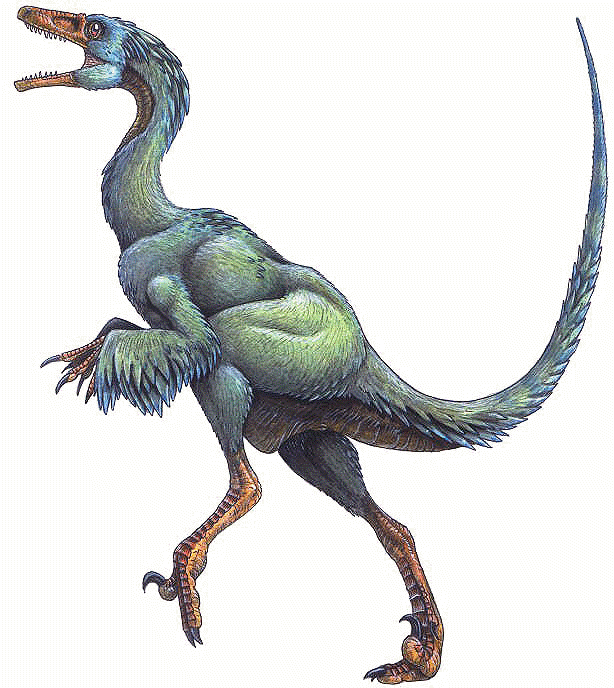Post by Barry the Baryonyx on Jun 29, 2007 14:12:55 GMT -5
Stenonychosaurus/Troodon

Pic (c) Feenixx Publishing, Inc.
Text © 2006 Answers Corporation
Troodon was a relatively small, bird-like dinosaur from the Late Cretaceous Period (75-65 mya). Discovered in 1855, it was among the first dinosaurs found in North America. It is believed to have been one of the most intelligent dinosaurs.
Characteristics
This small dinosaur was around 2 m (6.5 ft) in length, 1 m (3 ft) tall, and weighed 60 kg (130 lb). Its eyes were large (perhaps suggesting nocturnal activity) and slightly forward facing, giving Troodon some depth perception.
Troodon (pronounced "Tro-odon") is Greek for "wounding tooth", referring to the dinosaur's serrated teeth (although these may actually have been adapted for herbivorous feeding, see below). Its diet consisted of smaller animals, including mammals and perhaps a significant amount of plant material as well.
Troodon had long 'arms' that folded back like a bird's and its 'hands' possessed partially opposable thumbs. It had large, sickle-shaped claws on its second toes, which were raised off the ground when running. This claw is common in the group Maniraptora, to which Troodon belongs.
Troodon had one of the largest known brains of any dinosaur, relative to its body mass (comparable to modern birds). Eggs have also been discovered, in nests.
Distribution
Troodon is known from the Judith River Formation of Montana, the Judith River Group of Alberta, the Horseshoe Canyon Formation of Alberta, the North Slope of Alaska and in the famous Hell Creek Formation of the USA. There is some evidence that Troodon favored cooler climates, as it seems to have been particularly abundant in northern areas and during cooler intervals, such as the Early Maastrichtian. It seems unlikely that all of these fossils, which come from localities hundreds or thousands of miles apart, separated by millions of years of time, represent a single species of Troodon. However, further study and more fossils are needed to determine how many species of Troodon existed.
Biology
Troodon had very long, slender limbs, suggesting that the animal was able to move quite quickly. Although originally thought to have been a predator, there is some evidence that Troodon may either have been an omnivore or a herbivore. The jaws met in a broad, U-shaped symphysis similar to that of an iguana and the teeth were leaf-like, bearing large serrations like those of herbivorous dinosaurs. In addition, the teeth were short but broad, with wear facets on their sides. In these respects Troodon was again more like plant eating dinosaurs than carnivores such as Dromaeosauridae. A specimen of Troodon is known from Montana, sitting atop a clutch of eggs.
History
Troodon was originally spelled Troödon (with a diaeresis) by Joseph Leidy in 1856, which was officially amended to its current status by Sauvage in 1876.
The Troodon tooth was originally classified as a "lacertian" (lizard) by Leidy, but re-assigned as a megalosaurid dinosaur by Nopsca in 1901 (Megalosauridae having historically been a wastebin taxon for most carnivorous dinosaurs). In 1924, Gilmore suggested that the tooth belonged to the herbivorous pachycephalosaur Stegoceras, and that Stegoceras was in fact a junior synonym of Troodon (the similarity of troodontid teeth to those of herbivorous dinosaurs continues to lead many paleontologists to believe that these animals were omnivores). In 1945, Charles Hazelius Sternberg rejected the possibility that Troodon was a pachycephalosaur due to its stronger similarity to the teeth of other carnivorous dinosaurs.
The first specimen of Troodon that was not a tooth, then referred to its own genus (Stenonychosaurus), was named by Sternberg in 1932, based on a foot, fragments of a hand, and some caudal vertebrae from Alberta. A remarkable feature of these remains was the enlarged claw on the second toe, which is now recognized as characteristic of Deinonychosauria. Sternberg initially classified Stenonychosaurus as a member of the family Coeluridae. Later, Sternberg (1951) speculated that since Stenonychosaurus had a "very peculiar pes" and Troodon "equally unusual teeth", they may be closely related. Unfortunately, no comparable specimens were available at that time to test the idea.
A more complete skeleton of Stenonychosaurus was described by Dale Russell in 1969, which eventually formed the scientific foundation for a famous life-sized sculpture of Stenonychosaurus accompanied by its fictional, human-like descendant, the "dinosauroid". Stenonychosaurus became a well-known theropod in the 1980s, when the feet and braincase were described in more detail. Phil Currie, reviewing the known Troodontidae in 1987, reclassified Stenonychosaurus inequalis as a junior synonym of Troodon formosus. This synonymy has been widely adopted by other paleontologists, and therefore all of the specimens once called Stenonychosaurus are now referred to as Troodon in the recent scientific literature.


 Is it just us?
Is it just us?